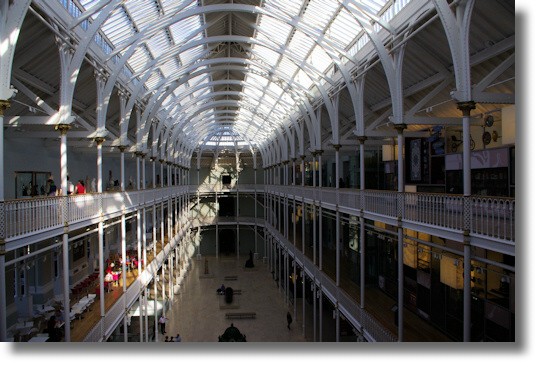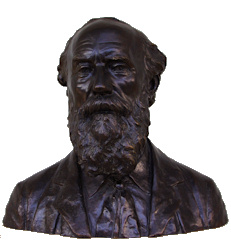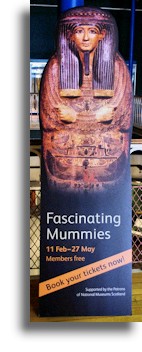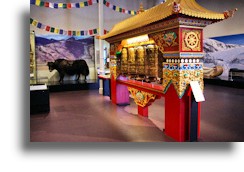
Places to Visit in Scotland
- Royal Museum of Scotland

Historical Background
The original Royal Museum of Scotland in Chambers Street in Edinburgh was begun in 1861 and partially opened in 1866. The Victorian facade and grand central hall was always a popular attraction but in 2006 a new "Museum of Scotland" was constructed next door (see graphic on the right). This incorporated collections of the former National Museum of Antiquities of Scotland and concentrated on Scottish history in an essentially chronological arrangement, beginning with prehistory to the early medieval period at the lowest level, with later periods up to the modern era in the higher levels.
A new organisation the "National Museum of Scotland" has become responsible for all the major museums in Scotland, including the National Museum of Rural Life at a former farm at Wester Kittochside in East Kilbride; the National Museum of Flight at East Fortune Airfield, East Lothian with aircraft ranging from biplanes to the supersonic airliner Concorde; the National War Museum in Edinburgh Castle; and the National Museum of Costume at Shambellie House, near Dumfries.
The new Museum of Scotland building somewhat overshadowed the older Royal Museum which covered natural history, world cultures, European decorative arts including costume, and technology. So in April 2008 the museum shut its doors to allow a £46.4 million transformation to take place and reopened in July 2011 to reveal one of the UK's largest museums with 20,000 objects spread across 36 galleries. The combined Museum of Scotland and Royal Museum is now called "National Museum of Scotland". If you want to see more on the former Museum of Scotland there is an illustrated article on Rampant Scotland in Places to Visit - Museum of Scotland page.
Main Entrance Hall
The entrance to the museum used to be up a flight of steps from street level. Now, there are two entrances at street level which allows immediate wheel chair access into a large entrance hall created from the original Victorian basement. This has been compared to a church crypt or a castle basement. In addition to accommodating some displays there is a gift shop and information point plus is a relaxing "brasserie". After several hours going round the building taking photographs I can vouch for the comfort and friendly service in what Glasgow folk would call an up-market café rather than brasserie!In addition to the usual low cost souvenir items, the museum shop has a useful selection of books, replicas, china ornaments, stationery and replicas of the Viking chess set uncovered on a beach on the Isle of Lewis. One aspect that surprised me was that nine months after the museum had re-opened following the major refurbishment there was still no guide book available.

Grand Gallery
The Grand Gallery's cast iron construction and natural lighting from the glass covered roof at the top of the building is modelled on the Crystal Palace which housed the "Great Exhibition" of 1851 in London. Before the recent major refurbishment it was the main entrance hall and much of the floor area was given over to two large fish ponds. There was an outcry from many in Edinburgh when the redevelopment plans swept these away to allow for more display items in the area.With two more floors soaring above the ground floor to the curved glass roof, the Grand Gallery is certainly impressive and as you wander round the display halls on the upper floors you inevitably keep coming out onto the circulation areas at each level. Indeed, the designers have taken advantage of that by creating a "Window on the World" with a display that runs through three floors of the gallery. Described as the " UK's largest single museum installation" it is 18 metres (almost 60 feet) high. Items range from the world's largest piece of scrimshaw (a carving of giant sperm whale jawbones by 19th century seamen), a large collection of colourful seashells, Buddhas, typewriters and teapots. The museum says that the objects in the display were assembled because they were surprising or beautiful or thought-provoking. Although you can examine it from close up, the best view of this exhibit is across the hall from the Balcony Café on Level 3.
Natural World
The building has another hall which rises to the full height of the building and this has been dedicated to the natural world with exhibits which demonstrate the diversity and evolution of planet Earth and the animal kingdom. So there are huge replicas of the skeletons of Tyrannosaurus Rex and Stegosaurus as well as many stuffed animals, birds and fish including a full size elephant, rhinoceros, polar bear, lions, flamingos and squid. Many of the fish were hanging suspended in mid air, fully using the full height of the display area.
Judging by the reaction of the young children who were being taken round the museum, this natural world area seemed to be very popular with them. The displays were not only eye catching but the information displays were helpful and informative - that was true of all the areas in the museum of course.

World Cultures
There are extended displays covering a number of areas throughout the museum showing objects which reveal how indigenous people in various parts of the world lived and expressed themselves through art, music and performance. There are large areas dedicated to Far Eastern countries such as China, Japan, Korea and Tibet as well as Indonesia. But there are also colourful displays with items from Canada, Australia and North American Indians and Ghana. Themed displays spread over three floors and include Facing the Sea, the only UK gallery dedicated to the cultures of the South Pacific.Of course, UK culture is not forgotten and is well represented by a series of display cases with furniture and other items (even a Mercedes automobile and a venerable bicycle get slipped in) illustrating life in Britain in different decades, back to 1900. One of the displays includes furniture designed by Charles Rennie Mackintosh.
Art and Sculpture

Most museums build up a collection of sculptures and the Royal museum is no exception with a large number of sculptures ranging from Greek worthies to famous Scots such as James Watt, Hugh Miller (see graphic on the right) and John Logie Baird. Although he was born in Northern Ireland, Lord Kelvin (seen on the left) did much of his important work at the University of Glasgow.
Additionally, sculptures illustrating Buddha and Vishnu rubbed shoulders with Cain and Abel, all with helpful information plaques to aid recognition and put the object into a cultural context. That was particularly the case on the "Traditions in Sculpture" display on the top floor with a long line of works and as I took pictures of the many information labels I was glad that I was using a digital camera which allowed such photography without the cost of film!

Special Exhibitions - Egyptian Mummies
The Royal Museum of Scotland plans to have regular special exhibitions on particular subjects which will be rotated on a regular basis. The first of these focused on "Fascinating Mummies" with a large collection of Egyptian mummies, coffins, artefacts and paintings illustrating life (and death) in the time of the Pharaohs. The treasures are from the world famous Egyptology collections of the National Museum of Antiquities in Leiden in Holland. They are displayed alongside objects from our National Museum of Scotland's own important collections which have contributed to the understanding of life, death and the afterlife in Ancient Egypt. This is the only opportunity to see this intriguing exhibition in the UK and will be replaced by another exhibition at the end of May, 2012.
Science and Technology
Exhibits in this category include communications, transport, scientific instruments, industry and engineering, showing how mankind has investigated the world and tried to make our lives better through the ages. One example of this is the optic from Inchkeith lighthouse designed by David A Stevenson, one of the amazing Stevenson dynasty which produced eight lighthouse engineers over five generations (but did not include author Robert Louis Stevenson who declined to follow in the footsteps of his ancestors). Their impact on lighthouses in Scotland is vividly demonstrated by a map showing all the lighthouses around Scotland built by the Stevensons - and the small number created by others! The "Communicate!" gallery tells the story of human communication - from jungle drums and smoke signals to Morse code and semaphore, telegrams and telephones to mobiles, email and more. Another gallery named "Shaping Our World" looks at ways in which scientific developments over the past 150 years have revolutionised the way we live. And you can find out how Scottish scientists, inventors and engineers have had a major impact in shaping the modern world.The area allocated to "Earth in Space" included a Scottish Saltire flag which was taken into space in 2006 on a mission to the International Space Station by NASA astronaut Nicholas Patrick. His mother was born on Skye.

Slide Show of 50 display items from the Royal Museum of Scotland
Although this page has a lot of illustrations, I took a lot more pictures and so have created a Web page with a slide show of a selection of 50 of these in thumbnail format leading to larger versions of the graphics - which you can also view as a slide show. So if you want a rapid trip around the Royal Museum of Scotland have a look at Royal Museum of Scotland - Slide Show.
More Information
The National Museum of Scotland (both the previously named Royal Museum and the new Museum of Scotland next door) is located in Chambers Street in Edinburgh - about a 10/15 minute walk from Princes Street in the centre of the city. Hours of opening are 10am to 5pm, seven days a week (apart from Christmas and New Year). Admission is free (though donations, large and small, are welcome!). There are also free guided tours.The main Web site for the National Museums Scotland is www.nms.ac.uk/.
Return to Index of Places to Visit
Where else would you like to go in Scotland?

